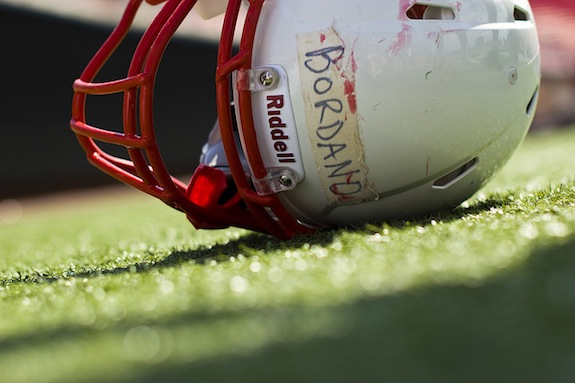There’s No Such Thing as a Concussion-Proof Helmet
Essentially, if you put 15 inches of foam on the outside of the helmet, you can make a concussion free helmet. But that’s completely impractical

Image: John McStravick
In football, one man wants to go somewhere, and his opponent doesn’t want him to. This basic tension leads to a lot of body smashing—big people slamming into one another at high speeds. It’s a recipe for concussions, which, despite the helmets that football players wear and the millions of dollars the NFL has poured into research on preventing brain injuries, are still a huge issue in the sport.
It seems like the obvious solution would be to improve helmets. But even the best football helmet anyone could dream up is not going to solve the NFL’s problem, says Mark Wilson, from Fast Company:
After talking to some of the brightest minds in helmet design, helmet testing and football physics, the elephant in the room became clear: A concussion-proof helmet is a pipe dream. If the NFL wants concussion-free football, they’ll need to redesign football.
Why? Well, for a number of reasons, says Wilson. There are certainly better and worse helmets. Researchers have ranked different designs by concussion risk. But even the very best helmet in the whole world still can’t keep players from rattling their brains around, says Fast Company:
The problem is ultimately one of physics. All helmets work under the same principle. The force striking one’s head–acceleration mixed with mass–can’t actually be prevented. Physics says that energy has to go somewhere, right? What good helmets do is lengthen the duration of the impact itself (in the hundredths of a second range), reverberating energy through various structures and materials, to smooth a hit from a sharp, high-g strike to a relatively smooth curve of deceleration. Consider landing on a concrete floor or a pile of pillows. Which impact takes longer and which impact hurts more?
“I think that it’s true that football helmets are 85% as good as they’re ever going to get,” Dr. Timothy Gay, University of Nebraska physics professor, writer, and industry helmet consultant tells me. “The optimal football helmet won’t be much better than the helmet you can buy right now because there are just physics restraints on the kind of padding you can use. We have a pretty good micro, nanotechnological understanding of how materials work. And basically, there are limits on what padding materials can do for a given thickness.”
Essentially, if you put 15 inches of foam on the outside of the helmet, you can make a concussion free helmet. But that’s completely impractical. Some have pointed to motorcycle and NASCAR helmets as something to aim for. Those drivers walk away from huge crashes unscathed. But those helmets aren’t designed for repeated blows, says Fast Company. “The downfall is that these helmets completely disintegrate upon impact—they’re totally ruined—with the interest of absorbing every bit of energy possible.”
What the NFL should focus on instead, Wilson argues, is rule changes that protect players. The problem is figuring out which rules to change. One rule that they changed just a few years ago has already had an impact, according to the NFL. In 2011, the league moved the kickoff spot up 5 yards, ESPN reports:
“The kickoff rule had an effect on the game,” said Rich McKay, chairman of the league’s competition committee. “There was a 40-percent reduction in concussions on that play.”
The league repeatedly has said the change to kicking off from the 35-yard line was done solely for player safety. McKay said Monday at the owners meetings it served that purpose.
Further rule changes could do the same, reducing the changes of full-on, full-speed hits. It’s up to the NFL to make them happen.
More from Smithsonian.com:
Even More Evidence That Football Causes Brain Injury
Football Tech to Protect Players
Leatherhead to Radio-head: The Evolution of the Football Helmet
/https://tf-cmsv2-smithsonianmag-media.s3.amazonaws.com/accounts/headshot/Rose-Eveleth-240.jpg)
/https://tf-cmsv2-smithsonianmag-media.s3.amazonaws.com/accounts/headshot/Rose-Eveleth-240.jpg)